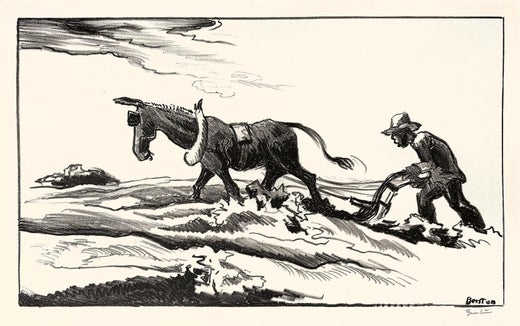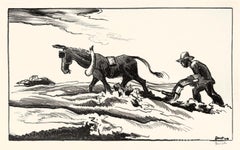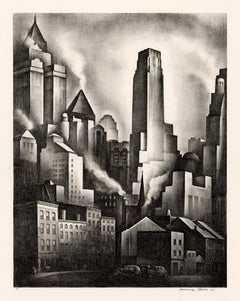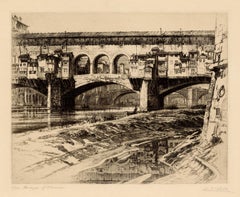Want more images or videos?
Request additional images or videos from the seller
1 of 2
Thomas Hart Benton'Goin' Home' — WPA Era American Regionalism1937
1937
Price:$2,925
$3,250List Price
About the Item
- Creator:Thomas Hart Benton (1889-1975, American)
- Creation Year:1937
- Dimensions:Height: 9.44 in (23.98 cm)Width: 11.88 in (30.18 cm)
- Medium:
- Movement & Style:
- Period:
- Condition:
- Gallery Location:Myrtle Beach, SC
- Reference Number:Seller: 1040881stDibs: LU532315424732
Thomas Hart Benton
Thomas Hart Benton was born in Neosho, Missouri on April 15, 1889. Even as a boy, he was no stranger to the "art of the deal" or to the smoke-filled rooms in which such deals were often consummated. His grandfather had been Missouri's first United States Senator and served in Washington for thirty years. His father, Maecenas Benton, was United States Attorney for the Western District of Missouri under Cleveland and served in the United States House of Representatives during the McKinley and Theodore Roosevelt administrations. Benton's brother, Nat, was prosecutor for Greene County, Missouri, during the 1930s. As soon as he could walk, Benton traveled with his father on political tours. There he learned the arts of chewing and smoking, and while the men were involved in their heated discussions, Benton delighted in finding new cream colored wallpaper on the staircase wall, at the age of six or seven, and drew in charcoal his first mural, a long multi-car freight train. As soon as he was eighteen, even though his father wanted him to study law, Benton left for Chicago where he studied at the Art Institute during the years 1907 and 1908. He continued his studies in Paris, where he learned delicious wickedness, aesthetic and otherwise. Once back home, he became the leader of the Regionalist School, the most theatrical and gifted of the 1930s muralists and as Harry Truman described him,"the best damned painter in America." Detractors said that Benton was "a fascist, a communist, a racist and a bigot"; the ingenious structure, powerful use of modeling and scale and the high-colored humanity of the murals and easel paintings are retort enough. He was a dark, active dynamo, only 5 ft., 3 1/2 in. tall. He was outspoken, open, charmingly profane; he had a great mane of hair and a face the texture of oak bark. He wore rumpled corduroy and flannel, and walked with the unsteady swagger of a sailor just ashore. He poured a salwart drink, chewed on small black cigars and spat in the fire. Benton was once described as the "churlish dean of regionalist art." If you listened to a variety of art authorities, you would find them equally divided between Harry Truman's assessment of Benton as "the best damned painter in America" and Hilton Kramer who proclaimed Benton "a failed artist." The East Coast art establishment tended to regard Benton as memorable for one reason only: he was the teacher of Jackson Pollock. Benton was married in 1922 to Rita, a gregarious Italian lady, and they had a daughter and a son. At the height of his fame in the 1940s, Benton bungled the buy-out he was offered by Walt Disney and went his own way, completing his last mural in 1975 in acrylics the year of his death. He died in 1975.
About the Seller
5.0
Recognized Seller
These prestigious sellers are industry leaders and represent the highest echelon for item quality and design.
Platinum Seller
Premium sellers with a 4.7+ rating and 24-hour response times
Established in 1995
1stDibs seller since 2016
321 sales on 1stDibs
Typical response time: 1 hour
Associations
International Fine Print Dealers Association
Authenticity Guarantee
In the unlikely event there’s an issue with an item’s authenticity, contact us within 1 year for a full refund. DetailsMoney-Back Guarantee
If your item is not as described, is damaged in transit, or does not arrive, contact us within 7 days for a full refund. Details24-Hour Cancellation
You have a 24-hour grace period in which to reconsider your purchase, with no questions asked.Vetted Professional Sellers
Our world-class sellers must adhere to strict standards for service and quality, maintaining the integrity of our listings.Price-Match Guarantee
If you find that a seller listed the same item for a lower price elsewhere, we’ll match it.Trusted Global Delivery
Our best-in-class carrier network provides specialized shipping options worldwide, including custom delivery.You May Also Like
Hydrofoil, Photorealist Lithograph by Raymond Loewy
By Raymond Loewy
Located in Long Island City, NY
Artist: Raymond Loewy, American (1893 - 1986)
Title: Hydrofoil
Year: 1978
Medium: Lithograph, signed and numbered in pencil
Edition: 300
Image Size: 17 x 24 inches
Size: 21 in. x 28 ...
Category
1970s American Realist Figurative Prints
Materials
Lithograph
Original War Fund Week Keep this Hand of Mercy at its work vintage poster
Located in Spokane, WA
Original WW1 poster: Keep this Hand of Mercy at its work. War Fund Week. One hundred Million Dollars. Original WW1 lithograph, archival line...
Category
1910s American Realist Landscape Prints
Materials
Lithograph
$500 Sale Price
20% Off
H 27.25 in W 20.25 in D 0.05 in
Original Windsor, See Britain by Train vintage poster
By Gordon Nicoll
Located in Spokane, WA
Original Windsor See Britain by Train vintage railroad poster. Linen backed in very fine condition, ready to frame. No restoration to t...
Category
1950s American Realist Landscape Prints
Materials
Lithograph
$1,720 Sale Price
20% Off
H 39 in W 24 in D 0.05 in
Original Historic Carlisle - Gateway to Scotland vintage railroad poster
Located in Spokane, WA
Original British vintage poster: Historic Carlisle - Gateway to Scotland. Artist: Maurice Greiffenhagen. Horizontal size 39" x 48.75". Archival linen-backed original stone lithograph; ready to frame. In very good to excellent condition.
Original, 1925 horizontal travel by train stone lithograph. Historic Carlisle ~ 800 years of Civic Independence. See Britain by train. British Railways. Published by British Railways (London Midland Region) LM 16657.
Probably the most famous British railway poster of the 1920s. The LMS commissioned designs from 16 leading Royal Academicians in 1924, of which this was by far the most popular.
A British Royal seal...
Category
1920s American Realist Figurative Prints
Materials
Lithograph
$2,760 Sale Price
20% Off
H 48.75 in W 39 in D 0.05 in
Original Chamonix Mont-Blanc vintage travel poster
Located in Spokane, WA
Original vintage travel poster Chamonix Mont-Blanc PLM French travel poster. Very good condition, archival linen backed. Ready to frame. ...
Category
1930s American Realist Landscape Prints
Materials
Lithograph
$8,500
H 39.38 in W 24.5 in D 0.07 in
Original Learn to Make and Test Big Guns vintage World War 1 poster
Located in Spokane, WA
"Learn to Make and Test the Big Guns" original vintage poster: linen backed. Grade A condition. Ordnance recruiting poster No. 2.
Better yourself – Enlist and learn a Trade in the Ordnance Department U.S.A. Linen-backed, horizontal, fine condition. A rare original poster.
Aberdeen Proving Ground …. Daily peacetime firing. Publisher: Washington, D.C.: Engineer Reproduction Plant, U.S. Army, 1919. OCLC: 51040606
The recruiting and training of artillery units were crucial to American victory in World War I. For the Saint-Mihiel offensive, General Pershing...
Category
1910s American Realist Landscape Prints
Materials
Lithograph
$1,560 Sale Price
20% Off
H 19.25 in W 25 in D 0.05 in
Put Fighting Blood in Your Business
Located in Spokane, WA
Original WW1 poster. Put Fighting Blood in Your Business. Here’s his record! Does he get a Job? Arthur Woods, Assistant to the Secretary of...
Category
1910s American Realist Landscape Prints
Materials
Lithograph
Original "Food Will Win The War" vintage World War 1 poster
By Charles E. Chambers
Located in Spokane, WA
Original World War 1 vintage poster: Food Will Wn the War. Arhival linen backed. PRINTER: Rusling Wood Litho., New York Bright and in good condition. There is some marks down the left side of the poster, possible ink from when the poster was printed.
This poster calls on immigrants to do their part in the war effort. It depicts recent immigrants standing near a sailing ship with the Statue of Liberty and a rainbow stretched across the New York City skyline in the background. The text reads:
You came here seeking Freedom.
You must now help preserve it.
Wheat is needed by the allies.
Waste nothing.
The generosity and compassion of the American people and the great agricultural resources of the North American continent would be called upon... Twenty million Americans signed pledges of membership in the Food Administration...
Category
1910s American Realist Figurative Prints
Materials
Lithograph
$1,100
H 30 in W 20 in D 0.05 in
Original Remember Your First Thrill of American Liberty 1917 vintage poster
Located in Spokane, WA
Original poster: Rembember Your First Thrill of Ameridan Liberty YOUR DUTY Buy United States Government Bonds 2nd Liberty Loan of 1917. Linen backed and ready to frame. Poste...
Category
1910s American Realist Figurative Prints
Materials
Lithograph
$650
H 30 in W 20 in D 0.2 in
Original Grindelwald Switzerland vintage curling winter sports poster
Located in Spokane, WA
Original vintage poster: GRINDELWALD SUISSE; vintage Swiss winter sporting poster created by Karl Toggweiler. Size 25.5" x 40"; c. 1960. Original lithograph. This Swiss curlin...
Category
1960s American Realist Figurative Prints
Materials
Lithograph
$1,518 Sale Price
20% Off
H 40 in W 25.5 in D 0.05 in
More From This Seller
View All'Plowing It Under' — WPA Era American Regionalism
By Thomas Hart Benton
Located in Myrtle Beach, SC
Thomas Hart Benton, 'Goin' Home', lithograph, 1937, edition 250, Fath 14. Signed in pencil. Signed in the stone, lower right. A fine, richly-inked impression, on off-white, wove pape...
Category
1930s American Realist Figurative Prints
Materials
Lithograph
'Financial District', New York City — American Modernism
By Howard Norton Cook
Located in Myrtle Beach, SC
Howard Cook, 'Financial District', lithograph, 1931, edition 75, Duffy 155. A fine, richly-inked impression, on cream wove paper, the full sheet with wide margins (2 3/4 to 5 5/8 inches), in excellent condition. Image size 13 5/16 x 10 3/8 inches (338 x 264 mm); sheet size 23 x 16 inches (584 x 406 mm). Matted to museum standards, unframed.
Literature: 'American Master Prints from the Betty and Douglas Duffy Collection', the Trust for Museum Exhibitions, Washington, D.C., 1987.
Collections: Crystal Bridges Museum of American Art, Library of Congress, Metropolitan Museum of Art, Philadelphia Museum of Art, Smithsonian American Art Museum.
ABOUT THE ARTIST
Howard Norton Cook (1901-1980) was one of the best-known of the second generation of artists who moved to Taos. A native of Massachusetts, he studied at the Art Students League in New York City and at the Woodstock Art Colony. Beginning his association with Taos in 1926, he became a resident of the community in the 1930s. During his career, he received two Guggenheim Fellowships and was elected an Academician in the National Academy of Design. He earned a national reputation as a painter, muralist, and printmaker.
Cook’s work in the print mediums received acclaim early in his career with one-person exhibitions at the Denver Art Museum (1927) and the Museum of New Mexico (1928). He received numerous honors and awards over the years, including selection in best-of-the-year exhibitions sponsored by the American Institute of Graphics Arts, the Brooklyn Museum, the Society of American Etchers, and the Philadelphia Print Club. His first Guggenheim Fellowship took him to Taxco, Mexico in 1932 and 1933; his second in the following year enabled him to travel through the American South and Southwest.
Cook painted murals for the Public Works of Art Project in 1933 and the Treasury Departments Art Program in 1935. The latter project, completed in Pittsburgh, received a Gold Medal from the Architectural League of New York. One of his most acclaimed commissions was a mural in the San Antonio Post Office in 1937.
He and Barbara Latham settled in Talpa, south of Taos, in 1938 and remained there for over three decades. Cook volunteered in World War II as an Artist War Correspondent for the US Navy, where he was deployed in the Pacific. In 1943 he was appointed Leader of a War Art Unit...
Category
1930s American Modern Figurative Prints
Materials
Lithograph
'Brooklyn Bridge' — Iconic New York City Landmark
By Luigi Kasimir
Located in Myrtle Beach, SC
Luigi Kasimir, 'Brooklyn Bridge', color etching with aquatint, 1927, edition 100. Signed in pencil.
A superb impression, with fresh colors, on heavy, cream wove paper; with margins...
Category
1920s American Modern Landscape Prints
Materials
Etching, Aquatint
'Bridges of Florence' — Firenze Impressionism
Located in Myrtle Beach, SC
Alonzo C. Webb, 'Bridges of Florence', etching, 1929, edition 100. Signed and titled in pencil. Signed and dated in the plate, lower left. A superb, richly-inked impression, in warm ...
Category
1920s American Impressionist Figurative Prints
Materials
Etching
'Chion-in Temple Gate' from 'Eight Scenes of Cherry Blossoms' — Jizuri Seal
By Hiroshi Yoshida
Located in Myrtle Beach, SC
Hiroshi Yoshida, 'Chion-in Temple Gate (Sunset)' from the series 'Eight Scenes of Cherry Blossoms (Sakura hachi dai: Sakura mon)', color woodblock print, 1935. Signed in brush 'Yoshida' and in pencil 'Hiroshi Yoshida'. A superb, early impression, with fresh colors; the full sheet with margins, on cream Japan paper; an area of slight toning in the top right sheet corner, not affecting the image, otherwise in excellent condition. Marked with a jizuri (self-printed) seal, upper left margin. Self-published by the artist.
Image size 9 5/8 x 14 3/4 inches (444 x 375 mm); sheet size 10 7/8 x 16 inches (276 x 406 mm). Archivally sleeved, unmatted.
Provenance: M. Nakazawa, Tokyo.
Literature: Japanese Landscapes of the 20th Century (Hotei Publishing calendar), 2001, May.
Collections: Honolulu Museum of Art, Museum of Fine Arts, Boston.
ABOUT THE IMAGE
Located in Kyoto, Chionin is the main temple of the Jodo sect of Japanese Buddhism, one of the most popular Buddhist sects in Japan, having millions of followers. The Sanmon Gate, Chionin's entrance gate, standing 24 meters tall and 50 meters wide, it is the largest wooden temple gate in Japan and dates back to the early 1600s. Behind the gate, a broad set of stairs leads to the main temple grounds.
ABOUT THE ARTIST
Painter and printmaker Yoshida Hiroshi (1876-1950) is regarded as one of the greatest artists of the Japanese 'shin hanga' (New Print) movement.
Yoshida was born as the second son of Ueda Tsukane in Kurume, Fukuoka Prefecture, a schoolteacher from an old samurai family. In 1891 he was adopted by his art teacher Yoshida Kasaburo in Fukuoka and took his surname. In 1893 he went to Kyoto to study painting, and the following year to Tokyo to join Koyama Shotaro's Fudosha private school; he also became a member of the Meiji Fine Arts Society. These institutions taught and advocated Western-style painting, greatly influencing Yoshida’s artistic development.
In 1899 Yoshida had his first American exhibition at Detroit Museum of Art (now Detroit Institute of Art), making the first of many visits to the US and Europe. In 1902 he helped reorganize the Meiji Fine Arts Society, renaming it the Taiheiyo-Gakai (Pacific Painting...
Category
1930s Showa Figurative Prints
Materials
Woodcut
New York Skyline, Sketch
By John Taylor Arms
Located in Myrtle Beach, SC
A fine impression, on cream wove paper, with full margins (5/8 to 1 3/8 inches), in excellent condition. Edition 20. Signed and dated in pencil. Annotated 'Bolton Brown...
Category
1920s American Realist Landscape Prints
Materials
Lithograph



